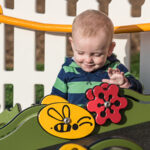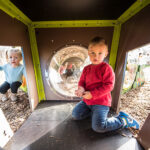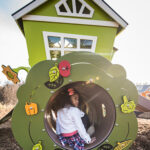We’re excited to introduce our guest blogger for Autism Awareness Month, Ariel Mansholt. She is an inclusive play specialist at Landscape Structures and a practicing occupational therapist in a Kansas school district. Ariel brings a rare and powerful dual perspective—professional expertise and personal experience—to the work of inclusive playground design, which welcomes children of all abilities.
Ariel’s passion for inclusive playground design is deeply rooted in her own childhood. She grew up with her older brother, Derek, who has autism, and her early experiences with him shaped not only her understanding of neurodiversity but also her career path. From swinging in the backyard—the place where Derek communicated most freely—to navigating local parks that didn’t meet his sensory needs, Ariel saw firsthand how the built environment can either open doors or create barriers for kids like her brother.
Now, through her work in both occupational therapy and inclusive playground design, Ariel helps shape play environments that support every child. Her story, Derek & Me, is a heartfelt reflection on family, inclusion and the power of thoughtful design. We’re honored to share her voice and vision with you.
Derek & Me—A guest post for Autism Awareness Month
Growing up things in my house looked a little different than that of my friends. My house was filled with binders that had pictures on them used to communicate, visual schedules, way more toy garbage trucks than one could ever possibly play with and very detailed routines. As I grew up, some of these items changed. The garbage trucks turned into K’NEX then into computer games. The one thing that did not change was the structured routines.



Every day after school, my mom and Derek would show us the new pictures added to his book with the accompanying sign. As we continued to grow up, Derek began communicating verbally. Following this shift, our after-school family time migrated to outside on our backyard swing set, which was always the place my brother was the most verbal. I then came to the age of wanting to learn how to ride a bike and so did Derek.
My path to occupational therapy
This was my first introduction to the world of occupational therapy. Our new routine included many activities outside that I later came to know worked on bilateral coordination and motor planning. It was after this preview to occupational therapy that I began to question more of the why behind the differences between my family and others. That’s when I learned about my brother’s diagnosis of autism and that his brain worked differently than mine did.
I had access to resources and books that allowed me to learn more about this diagnosis and become an advocate of Derek’s. The way that Derek’s brain works allows him to be super detail oriented and great at remembering specific things, skills that he has used to pursue a career in the culinary industry. My desire to pursue a career in occupational therapy came largely from my experiences with my brother. However, now being in my career for nearly 2.5 years, I can say that it truly is my dream career.
Bringing my perspectives to inclusive playground design
As an occupational therapist, I have worked in an outpatient setting as well as a school district helping children with a variety of diagnoses learn and acquire new skills. Additionally, I have been working with Landscape Structures Inc. to use my professional and personal lenses to create spaces where kids of all abilities and their families can connect.
From backyard joy to public spaces
These opportunities have challenged me to think back to Derek on the swing or our backyard pool and remember how much joy these experiences brought to not only Derek but my family. However, if we navigated to the local park or pool all of the joy was lost from these experiences. It often turned into heightened emotions and hurriedly getting back into the car and driving home. A lot of the difficulty was largely due to the increase in sensory stimulation within the environment. Reflecting on those experiences and seeing how far we’ve come brings a smile to my face. We are seeing an increase in neurodivergent affirming practice and designing our environment to support the needs of all, rather than a few.
Why inclusive playground design matters
Someone asked me recently about my thoughts on how designing an environment to support children of all abilities has impacted kids’ learning and overall growth. I think the impact has been tremendous—more social connections, more play opportunities and more physical activity. A child’s main occupation is to play. It’s how they learn! Designing spaces that support emotional regulation—especially for children with autism—helps them stay and engage longer. Staying longer gives children more chances to engage with peers and build social connections—something my brother has recently taken an interest in. Because the environment didn’t support his regulation, Derek missed out on core moment to engage with friends. Today, with more intentional design this is an opportunity we can create for today’s kids.
Having a range of complexity in our designs can also speak to the varying skill levels when it comes to motor skills for the autism population. The incorporation of climbers and net structures challenges motor planning and allows kids to work on that brain and body connection. When design has intentionality behind it and allows children of all abilities to play, the outcome is truly great. I have seen this with kids that I currently work with. When providing treatment on an inclusive playground, I see the joy and autonomy it brings along with social connections and opportunities for skill acquisition.
As an adult who enjoys the playgrounds as much as the kids, thanks for always wanting to inspire the fun that is at the heart of play. I know that younger Derek and Ariel would’ve had the BEST time at all of the playgrounds we’re designing today.


















